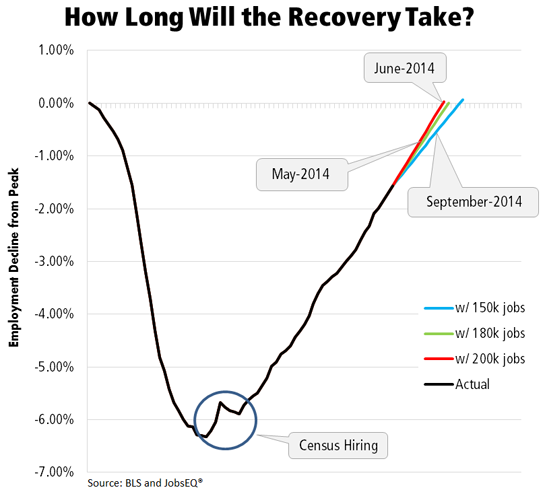The latest U.S. jobs report from early July indicates the national economy continues to add jobs at a slow but steady pace. The latest data indicates the economy has added approximately 195,000 jobs each month for the past three months. If we go back to January 2011, the nation added on average close to 185,000 jobs per month. The U.S. economy is gradually recovering and now the labor market may even be gaining some momentum.
In February 2010, the U.S. job market had hit rock bottom. From the pre-recession high of 138 million people employed, the economy had shed some 8.7 million jobs—more than 6% of total nonfarm employment had vanished. Since then, total nonfarm employment has grown to almost 136 million, which is only 1.5% below the former peak. It is likely—assuming the current pace of about 180,000 new jobs created per month continues—that the U.S economy will reach its previous peak of employment in mid-2014. At that point, the U.S. economy will be deemed to have fully “recovered” from the previous recession’s job losses.


However, while the jobs are coming back, they are not where we left them. As of the first quarter of 2013, in fact, a small number of states have already fully recovered the number of jobs lost during the last recession and have begun to set new records of employment. These states are Texas, North Dakota, Alaska, South Dakota, West Virginia, and Utah as well as the District of Columbia. Close behind these areas are another 14 states that have recovered between 98% and 99% of the jobs they lost during the previous recession—states like Massachusetts, New York, and Nebraska. These states, along with the U.S. economy as a whole, will likely regain their previous employment peak within the next 12 months.
For the remainder of the country, however, the recovery of lost jobs has been much less robust and many states remain well below their pre-recession employment levels. For instance, California’s economy was hit much harder in the previous recession than the nation; at its nadir, California had lost nearly 9% of nonfarm employment. California’s labor market is rebounding, but it still remains as of roughly 4% below its previous employment peak. It is likely that it will take California well into 2015 to recover its previous peak employment, whereas by then many other states will be setting new employment records. States like Arizona and Florida are more than 7% below their previous employment peaks, while Nevada and Michigan are more 10% below their peak nonfarm employment.
In many previous recessions, employment bounced back quickly in the nation, typically within two years of the recession starting and many times in the very same places that lost employment in first place. This recession has seen the slowest employment recovery since the Great Depression, and the jobs that are being created today are in different sectors of the economy and in different localities. The map below depicts by county how employment levels have recovered from the previous pre-recession peaks across the nation. While some areas of the country enjoy new employment records, many others are still years away from recovering all the jobs that were lost, and in some locations it is likely that the job market may never recover back to previous peak. The jobs are coming back, just not where we left them.
Source: JobsEQ®